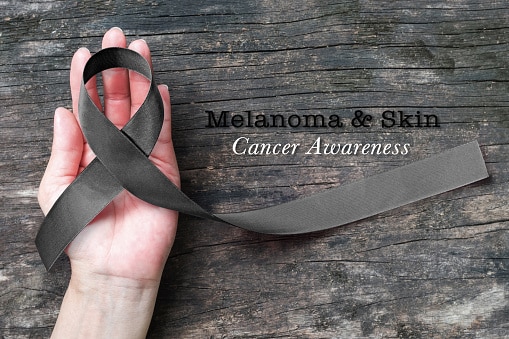Skin Cancer Awareness Month: The ABCDEs of Skin Cancer

The month of May is skin cancer awareness month and we want to show our support, how about you? The Dermatology Treatment and Research Center has helped many patients through their skin cancer diagnosis. Their specialists want to take this month to show our support for them and help others learn tips and tricks for spreading awareness of this disease and what to look for.
Asymmetry
Early detection of Melanoma and other forms of skin cancer are usually blemishes found on the body. More often than not, this takes on the form of moles or pimple-like bumps on the skin that may bleed rather than express pus. With that being said, it can be hard to distinguish what is a blemish on the skin and what is an onset sign of skin cancer. One of the ways to tell is if the individual in question has a mole that is asymmetrical, meaning the mole will not be even and one side is different in shape than the other. In most cases, this is a blatantly different look from one side to the other of the mole.
Borders
Paying attention to the borders of the blemish can be just as important when trying to discern an early sign of skin cancer. Just like how moles may be asymmetrical, their edges can also be different from what a usual mole looks like. A mole is typically contained in a round pattern or circle. However, if the edges appear jagged or uneven, this can be another way to tell that it is not a normal skin blemish. We encourage that if you’re not sure whether or not a mole is jagged or normal looking, to browse online. There are many examples out there that can portray a skin cancer mole compared to a normal one. Otherwise, if you’re still unsure or just want a clean bill of health, please don’t hesitate to come into the Dermatology Treatment and Research Center or see your primary care physician.
Color
This one is fairly simple. Most moles or skin blemishes have a light brown undertone or one that is simply a few shades darker than your typical skin tone. However, if you have a mole that is black, dark brown, blue, purple, or red/pink, you should have it looked at. And yes, they can come in all of those colors. It does depend somewhat on your skin tone, but if it looks strange in color in any way, it's time to give us or your primary care a call/visit.
Diameter
Moles are usually under a quarter inch in diameter. There can be some outliers to this rule that are not related to melanoma or skin cancer, but it is a safe rule to go off of. Experts encourage the use of all of these identifiers to make the most informed decision possible. If you have a mole that’s bigger than a quarter inch and is also oddly colored or has undefined edges, you should get it checked out just to be safe.
Evolving
If these blemishes/moles change in any way, this is one of the most obvious signs that it is skin cancer-related. Moles typically stay the same once they form, or change very gradually over the years. This is due to your body and skin getting older. If you notice colors changing, sizes changing, or anything that continues to shift, you should contact Dermatology Treatment and Research Center or get in touch with your primary care physician.
Knowing all these factors can help you spread awareness during the month of May. If you have any concerns about your skin or a loved one's, please feel free to recommend them or contact us yourself! The Dermatology Treatment and Research Center in Dallas, TX, has its doors open and waiting for anyone concerned about their health. Call today at 972.661.2729.